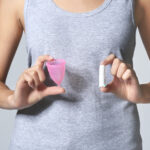Key Facts
- Tampons and pads aren’t out of the question when trying to be eco-friendly
- Period cups and underwear might not be for you and that’s OK
- Cloth pads may cost much less than the period cup or underwear
 What if period cups or underwear don’t fit my lifestyle?
What if period cups or underwear don’t fit my lifestyle?
It’s OK if period cups and underwear don’t fit your budget or your lifestyle; they are not for everyone. There are still several eco-friendly options available on the market.
You have options! Check out your local natural food store or larger supermarket chain, as many will carry non-chlorine bleached all-cotton pads and tampons. It’s important to mention that these products may be a bit more expensive than regular pads and tampons. They are disposable, so they aren’t as environmentally friendly as reusable products, but they’re not made using chemicals. However, even 100% natural cotton can contain pesticides, so if you want to be sure that the product you’re buying has no chemicals, it’s best to choose a brand made with organic cotton.
I’m looking for a tampon that will last longer like the cup or the underwear, do they exist?
Yes, Sea sponge tampons are an alternative to synthetic tampons that come in different sizes to absorb varying amounts of menstrual flow. The FDA in the United States has recommended that all menstrual sea sponges available seek FDA approval. Currently none are approved by the FDA. We recommend you talk to your clinician to learn more if you are interested in this product. The below content is general information about sea sponges.
These are not the same sponges that you might buy in a grocery store to wash dishes with. Sea sponges are from the ocean floor, and contain no synthetic materials. They are cleaned after harvesting (bleached with hydrogen peroxide) but are not sterile (free from bacteria or other living microorganisms) like synthetic tampons.
Sea sponges can be used multiple times for menses and washed between uses. To use the sponges you should follow the instructions that come with the product including specific instructions on how to place, remove, disinfect, and store the tampon and how often the specific tampon should be changed based on manufacturers recommendations. Menstrual sea sponges on average cost between $12-20 (for a package of two).
In general, before using a sea sponge tampon, you’ll have to dampen it, squeeze it tightly in your hand, and then gently insert it into your vagina. When the sponge is dry it’s surprisingly hard, but once dampened it softens up immediately. Once in place, it works like a tampon to absorb menstrual flow. A sea sponge needs to be rinsed out about every 3 hours and thoroughly cleaned, dried, and properly stored at the end of each menstrual cycle. Care must be taken to remove the sea sponge to avoid tearing it. One sea sponge will last about 6 months, but some may not last as long. A menstrual sea sponge should be thrown away and replaced if you notice that it rips apart while you’re inserting or removing it from your vagina (if this happens you should also speak to a clinician as you want to ensure all parts of a sponge have been removed from the vagina).
As with tampons, it is possible to get toxic shock syndrome from sea sponges.
What if I am not comfortable inserting anything into my vagina?
A great solution for you may be reusable, washable, cloth pads. They work just like regular disposable pads, but instead of throwing them away after use, you rinse them out, wash them, and use them again. Reusable pads usually come in two parts: a liner and a liner holder. The liner goes inside the holder, which has wings that snap around the crotch of your underwear to keep it in place. They come in different sizes and absorbencies and are usually less irritating because they are made of cotton, not plastic. Cloth pads are more expensive than disposables (when you first buy them) but they will save you money over time because they last for years. You change reusable pads as often as you would change disposable pads, except with reusable pads you hand or machine-wash them instead of throwing them away. Girls with sensitive skin or allergies may prefer cloth pads made with organic cotton.
Our health guides are developed through a systematic, rigorous process to ensure accuracy, reliability, and trustworthiness. Written and reviewed by experienced healthcare clinicians from Boston Children's Hospital, a Harvard Medical School teaching hospital and consistently ranked as a top hospital by Newsweek and U.S. News & World Report, these guides combine clinical expertise, specialized knowledge, and evidence-based medicine. We also incorporate research and best practices from authoritative sources such as the CDC, NIH, PubMed, top medical journals, and UpToDate.com. Clinical specialists and subject matter experts review and edit each guide, reinforcing our commitment to high-quality, factual, scientifically accurate health information for young people.